Dealing with vinyl liner stains
by Sally Bouorm | August 1, 2012 12:40 pm
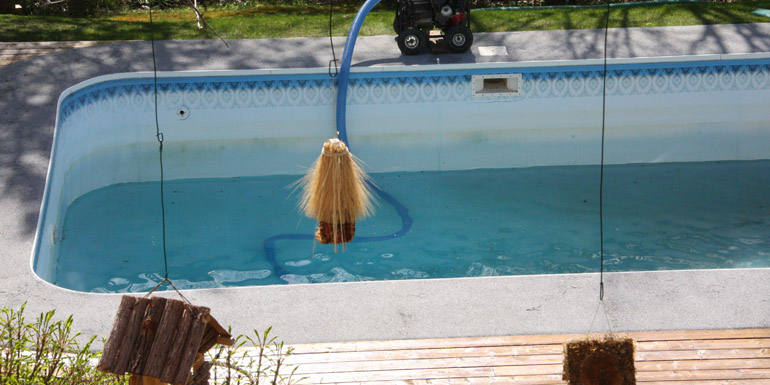 [1]
[1]By Carl Flieler
Vinyl pool liners, which are protected by special additives and coatings, can withstand the extremes of sunshine, heat, cold and constant exposure to chemically treated water. However, even the highest quality liner is still subject to staining, discolouration and other unsightly symptoms if proper water balance is not maintained, debris is allowed to remain in the pool and if water treatment chemicals are used improperly.
Pool professionals are often plagued by black and pink staining, blemishes from discolouration and bleaching, and byproducts commonly known as ‘pool tar.’ This article will help pool professionals identify the source and cause of various vinyl liner stains, as well as provide tips for removal and how to avoid them in the future.
Black staining
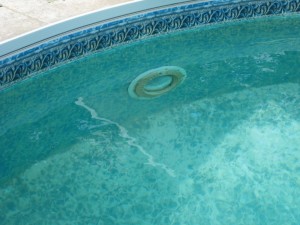 [2]
[2]Black staining on vinyl pool liners can originate from a number of sources, which primarily fall into two categories: metal staining and black algae. Depending on the type of stain, different treatments are required to correct the problem.
Metals
Copper (Cu), iron (Fe) and manganese (Mn) will form oxides in chlorinated pool water and can precipitate out of solution, resulting in stains that are generally black, brown or grey.
These metals may be introduced into the pool via the water source, while other metals for example can dissolve from copper or brass fittings in the plumbing if the pH of the pool water falls below seven and becomes acidic.
Copper may also be present in some algaecides; however, most of these products now use this metal in a chelated or complex form, which remains in solution.
The presence of metal staining can be confirmed by treating a small portion of the stained area with a pH reducer to dissolve the metals. If it can be removed or reduced, the staining is a result of metal deposits and any remaining stains can be treated in a similar manner. Once stains have been removed, the pool water should be treated with sequestering or chelating agents to prevent a reoccurrence.
Algae
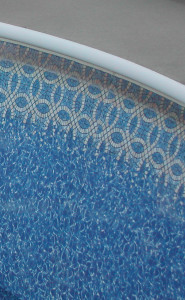 [3]
[3]If the stain cannot be removed from the liner by the treatment specified above, it is likely due to an organic source such as black algae. Black algae are tenacious organisms with a chlorine (Cl) resistant coating and appear as a series of small black spots. To remove these stains, a number of steps must be performed.
First, algae spots must be brushed (using a nylon brush) to open up the algae coating. The water’s pH should be tested and reduced to the lower limit of the normal operating range (i.e. 7.2) to improve chlorine effectiveness. Then, super chlorinate the pool water (normally to 10 parts per million [ppm] of free available chlorine) and add a dose of a quaternary (quat) algaecide. Be sure to follow the manufacturer’s dosage recommendations as excessive use may result in foaming. De-foaming products for swimming pools are available should this occur.
Continue brushing algae stains to maximize chemical penetration, then vacuum dead algae to the drain once they have been killed and removed from the vinyl liner.
One day after super chlorinating the water, add a dose of a polymer algaecide (polyquat) as per the manufacturer’s recommendations. Polyquats are more expensive than regular quaternary algaecides; however, they are more effective at controlling resistant strains of algae. Once stains have been removed, resume normal chlorination and water balance. Remember, the best protection against algae growth is maintaining free chlorine levels between one to three ppm.
Keep in mind, normal water balance parameters should be held within the following ranges:
- 80 to 120 ppm total alkalinity (TA);
- 7.2 to 7.6 pH; and
- 200 to 300 ppm calcium hardness.
Micro-organism activity
Another type of grey/black-coloured stain can occur as a result of micro-organism activity on the back side of the liner. These micro-organisms can produce dyes that are soluble in the plasticizers used to make the vinyl liner pliable. The microbial dye becomes visible on the pool side of the liner as it migrates through the liner material, creating an unsightly, irregular-shaped blotch.
These stains can be diminished on the pool side via super chlorination; however, they will eventually reappear since the source of the stain originates from behind the liner. Installation of a polyethylene barrier, between the vinyl liner and the pool’s walls and floor, may prevent these stains from occurring.
Finally, when closing a pool for the season, a winter or safety cover that seals tightly around the pool perimeter can be used to prevent organic debris (e.g. leaves and insects) from accumulating over the winter months. If the pool is not covered properly, this type of debris will accumulate and possibly cause staining, and discolouration on vinyl liner surfaces. Under certain conditions, one such unsightly result can be the formation of pink stains on the liner.
Pink staining
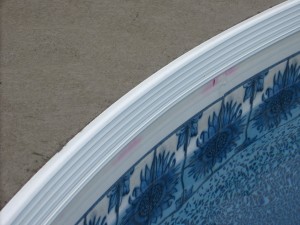 [4]
[4]Pink blotches, which can appear on vinyl liners of all colours, are typically caused by an indelible pink dye excreted by bacterial micro-organisms. This dye can easily migrate through the entire thickness of the liner as it is highly soluble in the plasticizers used in flexible polyvinyl chloride (PVC) pool liners.
Bacterial micro-organisms can grow on either side of the pool liner. For instance, growth on the water side of the liner may occur if free chlorine levels are allowed to fall below 1.5 ppm at the same time organic matter and bacteria have been allowed to accumulate in the water. At this stage, super chlorinating will rid the pool water of the contamination and bleach the portion of the dye that is exposed on the liner’s surface. However, if the dye has already penetrated the liner’s surface, staining will tend to linger indefinitely.
Further, growth on the backside of the liner may not take place directly on the vinyl but rather on other materials the liner is in contact with such as soil and various insulating materials (e.g. felt and tape). Even though anti-microbial agents are incorporated into the vinyl formulation, the dye can migrate from unprotected components and stain areas well beyond the point of infestation. If there is a lot of pink dye visible on the rear side of the liner or any backing material, it can certainly be considered the source of the problem.
If the liner is replaced, all contaminated materials must be removed and the entire pool shell (floor and walls) must be disinfected with a liquid chlorine spray or another suitable disinfectant.
Additional problems may also occur in low-lying areas or those with high water tables, which are more likely to contain higher concentrations of bacterial micro-organisms that are continually brought to the backside of the liner. Using disinfectants at these sites may prove to be ineffective as they will be quickly washed away. Installing a barrier layer—either a polyethylene sheet between the pool shell and liner or a coating applied directly to the pool shell—may work as a possible line of defense in these situations.
Stains from bleaching
The addition of water treatment chemicals can also damage a vinyl liner if they are not sufficiently circulated in the water. For example, chemicals such as chlorine can settle in the pool’s deep end and bleach the liner if the water is not circulated for several hours before the pool is closed for the season.
Spot bleaching can also occur if calcium hypochlorite (Ca[ClO]2) particles or other slow-dissolving sanitizers are allowed to settle on the pool floor. This can be easily prevented by dissolving sanitizers in a bucket of pool water prior to adding them to the pool. After the sanitizer has dissolved, pour it into the pool using a sieve.
Using large, single doses of hydrochloric (muriatic) acid to adjust pH or total alkalinity levels can also cause damage. Again, if the chemical is not sufficiently blended with the pool water, the acid can chemically attack the liner’s printed pattern.
Printed vinyl liners with base colours such as white, turquoise, light blue, grey and dark royal blue typically have excellent resistance to chlorine bleaching. However, medium blue vinyl liners are more susceptible to bleaching or colour loss, in as little as six to 24 hours, if exposed to high concentrations of trichloroisocyanurate stabilized chlorine. This is due to the chemical’s high available chlorine content (90 per cent), its low solubility or rate of dissipation (granules/pucks), and the extremely low pH produced in the contact area.
The immediate effect of other types of chlorine such as sodium dichloroisocyanurate (NaDCC), calcium hypochlorite, sodium hypochlorite (NaClO) (liquid chlorine) is not as rapid or severe as long as they are not dissolved and/or mixed with other chemicals during or shortly after being added to the pool.
These chlorine variations can usually be applied directly to the vinyl liner material for short-term exposures to bleach out stains without adverse effects. However, if the concentrations are allowed to remain higher than the recommended level of 5 ppm for super chlorination, or 10 ppm for shocking, for long periods of time, gradual bleaching of most liners will occur. It is always recommended to try a very small test area when attempting to remove a stain from a liner, and evaluate the results before proceeding with the treatment.
Further, any chemical added to pool water should be allowed to circulate before adding another chemical as certain combinations, at high concentrations, can also cause liner bleaching.
Pool tar
Sticky substances often referred to as ‘pool tar’ or ‘pool goo’ can adhere to, and cover, parts of a vinyl pool liner and appear as a stain. These substances are sometimes caused by the interaction between quaternary ammonium compounds used in some algaecides and decaying organic material such as leaves, grass and insects.
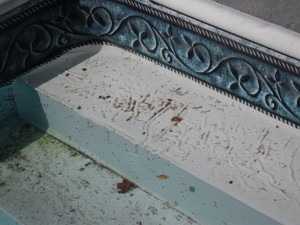 [5]
[5]Chlorine can also interact with quats to form a sticky material if both exceed the recommended levels. For instance, quats can easily come into contact with high chlorine levels in automatic chlorinators, which can result in a gummy substance being gradually fed into the pool where it will eventually precipitate onto the liner. These substances can form when organic materials from cosmetics or tanning/sunscreen lotions are oxidized by high chlorine concentrations, resulting in a beige waxy substance.
Although it is not harmful to swimmers, sometimes a light coating of vinyl plasticizer material, which turns dark when contaminated with dirt, may rise to the liner surface of newly installed liners during the first idle period of winterization. This is attributed to lack of circulation, as this reaction has never been observed in a swimming pool that has been circulated over the winter. The plasticizer material will typically be reabsorbed or oxidized at the liner surface in two to three weeks if the pool water is allowed to warm up (above 21 C [70 F]) and circulate before being shocked with chlorine (6 to 8 ppm) every other day.
Author note:
The information in this article is based on the strength of high quality, 100 per cent virgin-vinyl sheeting. Low-quality vinyl sheeting and/or inferior inks and printing processes will not likely withstand the chemical hardships described above. Builders should be aware of the quality of vinyl being used in the pool liners they purchase, install and service.
 Carl Flieler is a product development specialist with Canadian General-Tower Ltd., a vinyl-liner manufacturer in Cambridge, Ont. He is a professional engineer with more than 10 years experience in printed, vinyl-film formulation and manufacturing. He can be reached via e-mail at carl.flieler@cgtower.com[6].
Carl Flieler is a product development specialist with Canadian General-Tower Ltd., a vinyl-liner manufacturer in Cambridge, Ont. He is a professional engineer with more than 10 years experience in printed, vinyl-film formulation and manufacturing. He can be reached via e-mail at carl.flieler@cgtower.com[6].
- [Image]: http://poolspamarketing.com/wp-content/uploads/2012/08/IMG_4308.jpg
- [Image]: http://www.poolspas.ca/wp-content/uploads/2015/05/Brown-Stain-1.jpg
- [Image]: http://www.poolspas.ca/wp-content/uploads/2015/05/staining-photo.jpg
- [Image]: http://www.poolspas.ca/wp-content/uploads/2015/05/IMG_0572.jpg
- [Image]: http://www.poolspas.ca/wp-content/uploads/2015/05/wrinkes-stains-on-vinyl-liner-VynAll.jpg
- carl.flieler@cgtower.com: mailto:carl.flieler@cgtower.com
Source URL: https://www.poolspamarketing.com/trade/dealing-with-vinyl-liner-stains-2/